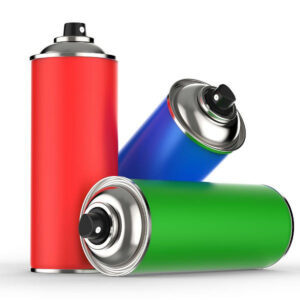Written on: May 1, 2022 by W. Stephen Tait
Hello, everyone. The Corrosion Corner column turns 22 years old this month. Thank you all for your support and interest over the years.
Can spray package corrosion tests accurately predict actual spray package corrosion? The short answer is Yes. However, using inappropriate protocols produces inaccurate corrosion data that often leads to wrong conclusions about long-term commercial filled-package corrosion. The most common of these inappropriate protocols can be grouped into one of the following seven categories:
1. Using high temperatures to accelerate package corrosion
2. Short storage-stability test lengths (<1 year)
3. Insufficient numbers of test samples
4. Inappropriate test parameters
5. Not evaluating the effect of formula and package variability on filled-package corrosion
6. Not determining the effective corrosion inhibitor concentration range
7. Not conducting follow-up corrosion tests on filled packages from first product
Let’s briefly discuss each.
1) Using high temperatures to accelerate package corrosion
Accelerating corrosion is desirable because—if successful—the length of a storage test could be shortened, allowing products to be introduced more quickly into the market. However, package corrosion rates are typically not accelerated by higher temperatures. In some instances, higher temperatures cause formula ingredient degradation that contributes to or causes spray package corrosion. In other instances, corrosion is retarded or inhibited by higher temperatures. This last phenomenon occurs frequently, but the reason why it occurs is still unknown.
2) Short storage test lengths (<1 year)
Shortening storage test lengths comes from the wish to accelerate package corrosion rates with higher temperature (>20–25°C/ >68–77°F). However, corrosion—in particular pitting corrosion—is not affected by the magnitude of temperature because it takes time to initiate pitting, increase newly initiated pits to the critical pit size needed to sustain continuous pit penetration into/through the package and generate enough corrosion to be seen with the unaided eye.
I’ve noted numerous instances where pitting corrosion was first seen at around the six-to-nine-month examinations and containers subsequently perforate at around one year. In other words, earlier examination times (<6 months) failed to detect corrosion that caused early failures (<1 year).
3) Insufficient number of test samples
Limited storage test-room space might restrict the number of spray packages per test. The result is stability tests with limited numbers of samples for each examination time (pull-time). Small sample numbers cause both low-test result statistical confidence and can be too low to discover the corrosion that will cause package failure.
For example, it is unlikely you will find pitting corrosion by examining only three packages, particularly if the probability of leaking is only 1%—0.1 x 3 packages ~ 0.03 corroded packages. In other words, essentially no corroded packages were found during examination in this instance. However, a 1% failure level is high enough to produce noticeable consumer complaints—0.01 x 10,000,000 filled-packages per year ~ 100,000 consumers with leaking packages each year.
4) Inappropriate test parameters
Package corrosion tests can be either a constant temperature storage-stability test or an electrochemical corrosion test. Let’s briefly discuss the inappropriate parameters for both.
Storage stability tests
Sometimes aerosol containers are evaluated for corrosion in several orientations: upright, inverted and on their sides. The upright and inverted orientations typically provide virtually the same results.
However, I’ve observed multiple instances where containers stored on their sides had both different types of corrosion and they corroded more quickly than those stored  upright. Hence, it is recommended to include corrosion evaluation with containers on their sides only when the purchased containers are expected to be stored sideways. Storing containers at high temperatures beyond one month typically does not simulate the actual package environment, because the cumulative time each year that packages are at higher temperatures is typically less than 30 days in most warm-to-hot climates. Also, the temperature chosen for stability tests should reflect the actual high temperatures for a given geographical area.
upright. Hence, it is recommended to include corrosion evaluation with containers on their sides only when the purchased containers are expected to be stored sideways. Storing containers at high temperatures beyond one month typically does not simulate the actual package environment, because the cumulative time each year that packages are at higher temperatures is typically less than 30 days in most warm-to-hot climates. Also, the temperature chosen for stability tests should reflect the actual high temperatures for a given geographical area.
In summary, inappropriate storage stability test protocols could include one or more of the following:
• Test time is too short
• Unrealistic container orientations
• Unrealistic higher storage temperatures
• Unrealistic storage time at higher temperatures
• The number of examined packages is too small (see the discussion of category #3)
Electrochemical corrosion testing
Electrochemical corrosion tests only yield accurate predictions with the appropriate test protocols, such as:
• Test length
• Measurement protocol
• Number of replicate samples
• Models to extract corrosion parameters
• Models to analyze and interpret parameter data
5) Not evaluating the effect of formula and package variability on filled-package corrosion
Variability often contributes to or causes random occurrences of spray package corrosion. Variability includes:
• Formula ingredient concentration variability
• Variability of contaminant concentrations, such as water in anhydrous formulas
• Package material composition variability
• Variability of package component physical attributes, such as valve crimp (clench) dimensions
6) Not determining the effective concentration range for corrosion inhibitors
Small concentrations of corrosion inhibitors are often very effective in preventing and/or controlling package corrosion. However, corrosion inhibitors often have an effective concentration range, above and below that which package corrosion occurs. Hence, the effective inhibitor concentration range should be determined during inhibitor development and that range should be part of the product specifications.

7) Not conducting follow-up corrosion tests on containers from first production
A corrosion storage-stability test completed after one year has an approximately 7% risk of corrosion occurring in commercially filled packages. Consequently, it is advisable to also run confirmatory storage tests on filled packages from several early production batches of the product to determine the variability effect on filled-package corrosion.
I realize that the best practices noted in this month’s Corrosion Corner can strain both personnel resources and storage-test facility resources, hence my preference for electrochemical corrosion testing as the main spray package corrosion test. However, electrochemical tests need the correct test parameters—data analysis and interpretation protocols to provide accurate predictions for actual corrosion.
Thanks for your interest and I’ll see you in June. Contact me at 608-831-2076, rustdr@pairodocspro.com or from our two websites: pairodocspro.com and aristartec.com. SPRAY